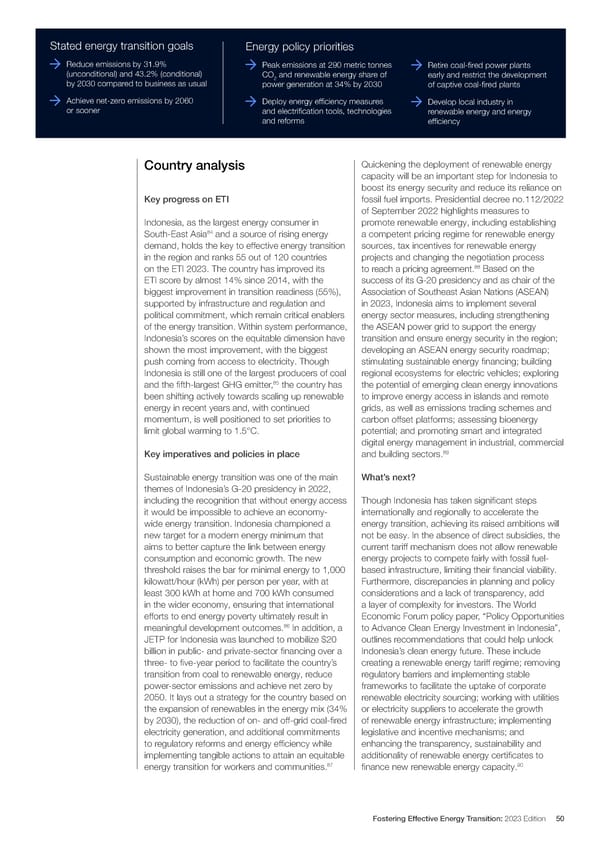Stated energy transition goals Energy policy priorities Reduce emissions by 31.9% Peak emissions at 290 metric tonnes Retire coal-昀椀red power plants (unconditional) and 43.2% (conditional) CO2 and renewable energy share of early and restrict the development by 2030 compared to business as usual power generation at 34% by 2030 of captive coal-昀椀red plants Achieve net-zero emissions by 2060 Deploy energy ef昀椀ciency measures Develop local industry in or sooner and electri昀椀cation tools, technologies renewable energy and energy and reforms ef昀椀ciency Quickening the deployment of renewable energy Country analysis capacity will be an important step for Indonesia to boost its energy security and reduce its reliance on Key progress on ETI fossil fuel imports. Presidential decree no.112/2022 of September 2022 highlights measures to Indonesia, as the largest energy consumer in promote renewable energy, including establishing 84 and a source of rising energy South-East Asia a competent pricing regime for renewable energy demand, holds the key to effective energy transition sources, tax incentives for renewable energy in the region and ranks 55 out of 120 countries projects and changing the negotiation process 88 on the ETI 2023. The country has improved its to reach a pricing agreement. Based on the ETI score by almost 14% since 2014, with the success of its G-20 presidency and as chair of the biggest improvement in transition readiness (55%), Association of Southeast Asian Nations (ASEAN) supported by infrastructure and regulation and in 2023, Indonesia aims to implement several political commitment, which remain critical enablers energy sector measures, including strengthening of the energy transition. Within system performance, the ASEAN power grid to support the energy Indonesia’s scores on the equitable dimension have transition and ensure energy security in the region; shown the most improvement, with the biggest developing an ASEAN energy security roadmap; push coming from access to electricity. Though stimulating sustainable energy 昀椀nancing; building Indonesia is still one of the largest producers of coal regional ecosystems for electric vehicles; exploring 85 the country has the potential of emerging clean energy innovations and the 昀椀fth-largest GHG emitter, been shifting actively towards scaling up renewable to improve energy access in islands and remote energy in recent years and, with continued grids, as well as emissions trading schemes and momentum, is well positioned to set priorities to carbon offset platforms; assessing bioenergy limit global warming to 1.5°C. potential; and promoting smart and integrated digital energy management in industrial, commercial Key imperatives and policies in place 89 and building sectors. Sustainable energy transition was one of the main What’s next? themes of Indonesia’s G-20 presidency in 2022, including the recognition that without energy access Though Indonesia has taken signi昀椀cant steps it would be impossible to achieve an economy- internationally and regionally to accelerate the wide energy transition. Indonesia championed a energy transition, achieving its raised ambitions will new target for a modern energy minimum that not be easy. In the absence of direct subsidies, the aims to better capture the link between energy current tariff mechanism does not allow renewable consumption and economic growth. The new energy projects to compete fairly with fossil fuel- threshold raises the bar for minimal energy to 1,000 based infrastructure, limiting their 昀椀nancial viability. kilowatt/hour (kWh) per person per year, with at Furthermore, discrepancies in planning and policy least 300 kWh at home and 700 kWh consumed considerations and a lack of transparency, add in the wider economy, ensuring that international a layer of complexity for investors. The World efforts to end energy poverty ultimately result in Economic Forum policy paper, “Policy Opportunities 86 In addition, a to Advance Clean Energy Investment in Indonesia”, meaningful development outcomes. JETP for Indonesia was launched to mobilize $20 outlines recommendations that could help unlock billion in public- and private-sector 昀椀nancing over a Indonesia’s clean energy future. These include three- to 昀椀ve-year period to facilitate the country’s creating a renewable energy tariff regime; removing transition from coal to renewable energy, reduce regulatory barriers and implementing stable power-sector emissions and achieve net zero by frameworks to facilitate the uptake of corporate 2050. It lays out a strategy for the country based on renewable electricity sourcing; working with utilities the expansion of renewables in the energy mix (34% or electricity suppliers to accelerate the growth by 2030), the reduction of on- and off-grid coal-昀椀red of renewable energy infrastructure; implementing electricity generation, and additional commitments legislative and incentive mechanisms; and to regulatory reforms and energy ef昀椀ciency while enhancing the transparency, sustainability and implementing tangible actions to attain an equitable additionality of renewable energy certi昀椀cates to 87 90 energy transition for workers and communities. 昀椀nance new renewable energy capacity. Fostering Effective Energy Transition: 2023 Edition 50
 Fostering Effective Energy Transition 2023 Page 49 Page 51
Fostering Effective Energy Transition 2023 Page 49 Page 51